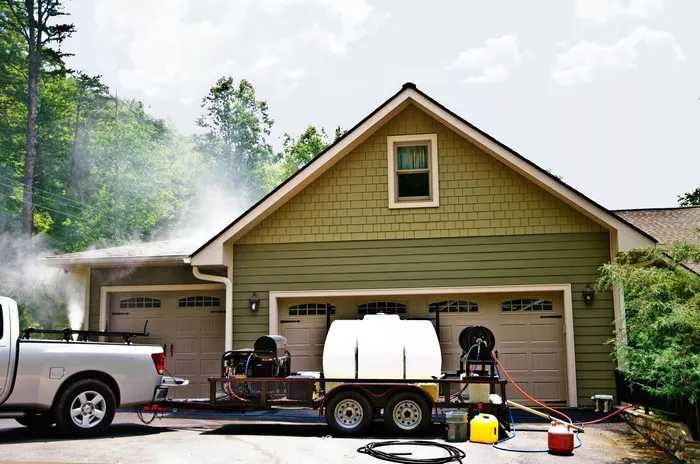Pressure washing, also known as power washing, is a highly effective method for cleaning various surfaces, including houses. It utilizes a high-pressure stream of water to remove dirt, grime, mold, mildew, and other unwanted substances from exterior surfaces. Whether it’s siding, concrete, brick, or wood, pressure washing can rejuvenate the appearance of your home, leaving it looking fresh and well-maintained.
Safety Precautions
Safety should always be the top priority when using pressure washers. Before starting any pressure washing project, it’s essential to wear protective gear to prevent injuries. This includes safety goggles to shield your eyes from debris, gloves to protect your hands, and sturdy footwear with good traction to prevent slips and falls.
Equipment Needed
To embark on your pressure washing journey, you’ll need the following equipment:
1. Pressure washer: Choose a model appropriate for the size and scope of your project.
2. Extension wand: Provides reach for high or hard-to-reach areas.
3. Nozzles: Different nozzles produce varying spray patterns for different cleaning tasks.
4. Detergent: For stubborn stains or mildew, opt for a suitable detergent designed for pressure washers.
5. Safety equipment: Goggles, gloves, and appropriate footwear are essential for safety.
Preparation
Before firing up the pressure washer, take time to prepare the area:
1. Remove obstacles such as furniture, toys, or debris from the work area.
2. Cover electrical outlets and fixtures to prevent water damage.
3. Wet nearby plants and landscaping to protect them from potential damage.
Choosing the Right Pressure Washer Settings
The key to effective pressure washing is selecting the appropriate pressure and nozzle for the surface you’re cleaning.
1. For delicate surfaces such as siding or wood, use lower pressure settings and a wider spray pattern to avoid damage.
2. For tougher surfaces like concrete or brick, higher pressure settings and narrower spray patterns may be necessary to achieve optimal results.
Techniques for Effective Cleaning
To ensure thorough cleaning without causing damage, follow these step-by-step instructions:
1. Start from the top and work your way down.
2. Hold the pressure washer at a consistent distance from the surface, typically 6 to 18 inches.
3. Use overlapping strokes to prevent streaks and ensure even coverage.
4. Pay extra attention to heavily soiled areas, but avoid lingering in one spot for too long to prevent damage.
Using Detergent
If dealing with stubborn stains or mildew, using detergent can enhance cleaning effectiveness.
1. Apply detergent using a low-pressure setting and allow it to dwell for a few minutes before rinsing.
2. Use a detergent specifically formulated for pressure washers to avoid damaging the equipment or the surface being cleaned.
Rinsing and Drying
Once the cleaning process is complete, thoroughly rinse away detergent and dirt residue:
1. Switch to a clean water nozzle and rinse from top to bottom.
2. Ensure all detergent and debris are completely washed away.
3. Allow the surface to air dry thoroughly before assessing the results.
Maintenance Tips
Proper maintenance of your pressure washer equipment is crucial for optimal performance and longevity:
1. Regularly inspect hoses, nozzles, and fittings for signs of wear or damage.
2. Clean the pressure washer after each use to prevent clogs and buildup.
3. Follow manufacturer’s guidelines for maintenance and storage to prolong the lifespan of your equipment.
Safety Tips and Troubleshooting
In addition to wearing protective gear, here are some additional safety tips:
1. Never point the pressure washer nozzle at yourself or others.
2. Avoid spraying near electrical outlets or wiring to prevent electric shock.
3. If you encounter any issues such as loss of pressure or strange noises, stop operation immediately and troubleshoot the problem.
Environmental Considerations
As responsible users of pressure washers, it’s important to minimize environmental impact:
1. Choose biodegradable detergents to reduce harm to the environment.
2. Use water-efficient pressure washer models and avoid excessive water usage.
3. Properly dispose of wastewater in accordance with local regulations to prevent contamination.
Conclusion
Mastering the art of pressure washing can transform the appearance of your home’s exterior, leaving it looking clean and well-maintained. By following the steps outlined in this guide and prioritizing safety and environmental considerations, you can achieve professional-quality results while preserving the beauty of your surroundings. So, gear up, follow these guidelines, and get ready to give your home the facelift it deserves!

